Revolutions are a dirty business in every country they occur in. Libya is no exception.
Moammar Gadhafi was a terrible human being. He was a thorn in the side of 5 US Presidents. He actually did pursue a WMD program, only giving it up in 2006. Under him, Libya was a state sponsor of terrorism and was behind the destruction of Pan Am flight 103. At home, he brutally repressed his population and ruled with an iron fist. In short, he was not a nice person.
According to a report on the BBC that I was listening to on the drive home, he was found hiding in a drain pipe in Sirte. He begged for his life, and was shot in the abdomen and again in the leg. Supposedly he “died” en route to a hospital, but at least one report mentioned an execution-style shot to the head.
Now, is this what happened? There’s no way to know, and I suspect we never will for sure. And yet, I find myself having some difficulty taking any “joy” in his death, especially a death such as that. No man who begs for his life should be killed, especially without due process. I would much rather have seen him turned over to ICJ authorities and tried for crimes against humanity.
And yet, it may have been the best possible outcome. Libya is not a stable country at this time and probably lacks the facilities to hold Gadhafi securely. There would be months of negotiations that would have to happen before he even got to a trial. All that time, his continued defiant existence would continue to empower his dwindling base. With him out of the picture, the rebels / new government should have little problem establishing itself as the new legitimate government of Libya, thus drawing a close to this whole thing even faster.
Revolutions are a dirty business.
